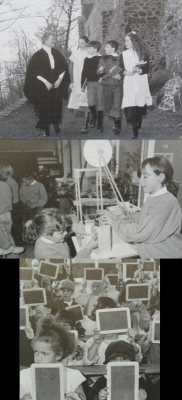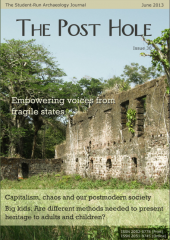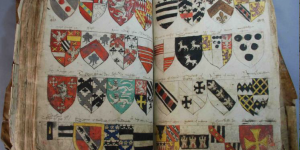For the presentation of heritage to adults, there are inconsistencies between the advice provided by the academic community and the physical forms of heritage presentation, whether in museums, television or other media. These inconsistencies have meant that there is now a divide, which arguably should not exist, between the methods used to present heritage to children and those used to present it to adults. This article will review the methods advised to present heritage to children and adults, highlight the inconsistencies between this advice and its application, and explore the reasons for these inconsistencies being present, as well as suggesting future directions for the field of heritage studies and museology.
Presenting heritage to children: Methodology and application
The scholarly discourse surrounding the methods which are most effective in communicating heritage to children has flourished in the last 30 to 40 years with the dawn of the digital age and the emergence of new forms of communication technology such as television, radio, and more recently, touchscreen technology. Presenting the past to children is often clearly defined by academics, with sections or whole works being specifically dedicated to children (Rider and Illingworth 1997; Black 2005).
When presenting heritage to children it has been argued that responsive, colourful and stimulating exhibitions are required (Hooper-Greenhill 1994; McManus 1996; O’Neill 1999). To achieve this, many stress the importance of having multi-sensory and interactive features in addition to role-playing and a diversity of content (Cohen 1996; Black 2005).
Another key component of the presentation of heritage to children it is argued, is the presence of a clear orientation in heritage content, where the child can satisfy their curiosity and challenge themselves, but ultimately control their environment and rate of learning (Falk and Dierking 2000). Finally it is generally perceived that the immersion in heritage for children should be an experience akin to playing and games, rather than school and academic work (Thomas 1994).
These recommendations are generally accepted by the majority of the academic community and their presence in both museums and other forms of heritage content is apparent. For example, the Jorvik Viking Centre in York is a heritage site marketed mainly to families with children and features multi-sensory exhibits with Viking sounds, smells and sights (anon. n.d.b). The site also has a clearly defined route, along which visitors can touch Viking objects and even play Viking games (anon. n.d.b).
Similarly interactive features can be seen at other ‘child focused’ museums and exhibits such as the ‘Mudlark’s’ section of the Museum of London, which is described as an “interactive play area” (Museum of London n.d.). Outside of the museum sector, TV shows such as the 1980s series ‘Voyager’s’ have been created specifically for families and children, utilising dramatics, problem solving and a diverse range of topics to engage their audience (anon. n.d.a). Therefore, it is clear that there is consistency between the recommendations provided by the academic community and the practical application of those recommendations in the presentation of heritage to children.
Presenting heritage to adults: Methodology and application
The literature on the methods for presenting heritage to adults is far less clearly defined than that relating to children. It is common for adults not to be defined as a separate audience and to instead be referred to simply as ‘visitors’ (Hooper-Greenhill 1991; Black 2005). Some, such as Hooper-Greenhill (1991), argue that adult engagement in heritage should often centre on specific events such as lectures, practical courses and fairs.
However, upon detailed inspection, it is clear that, for the most part, many of the methods highlighted as important in the presentation of heritage to adults are almost identical to those suggested for children. For instance, Black (2005) and Pitman-Gelles (1981) propose that clear orientation in museums and the ability to handle objects are vital in engaging all visitors. This is a view supported by others such as Moscardo (1996), Ambrose and Paine (2006) and Whitcomb (2003) who also add that interactive features and the ability of the individual to participate and structure their own learning is vital in captivating the attention of visitors of all ages. In essence, scholars suggest, although perhaps not always explicitly, that the methods of presenting heritage to adults and children are fundamentally the same.
Naturally, the content used in these methods must be adapted in terms of intellectual level for adults and children. Yet, based on the literature alone it would not be foolish to expect that the methods used in the presentation of heritage to children and adults should be almost identical, with content being the only differing factor. However, contrary to this assumption, it would appear that in many cases the literature on the presentation of heritage to adults does not reflect current practice.
The museum environment, for adults, it can be argued has changed very little in the last 250 years. For example, the British Museum features cabinets with long bodies of associated descriptive text, almost no interactive features and no clear route of trail for an adult visitor to follow. Although audio guides can be acquired for free (British Museum n.d.a), it could be argued that the way in which the content of the British Museum is presented to adults has essentially changed very little since its founding in 1753 (Caygill 1981).
By contrast, a child or family entering the British Museum is provided with dedicated additional materials, which feature clearly labelled trails to follow and interactive components such as treasure hunts, cartoons and puzzles, which are ultimately designed to heighten the experience and encourage learning (British Museum n.d.b). In addition to museums, other forms of heritage presentation are equally unreflective of the literature. For instance, TV shows and series such as ‘Archaeology: A secret history’ are often highly descriptive, narrative-driven and lacking of content diversity (British Broadcasting Corporation 2013).
There is thus a clear disparity and inconsistency between the literature on the presentation of heritage to adults and its practical applications. This is in spite of methods of good presentational practice, such as clear orientation, interactive features and the ability to explore and handle objects being seen by the field of museology and heritage studies as being equally valid for both adults and children. The question, therefore, arises as to why practically these methods have only been applied to children. While there is no physical data that may answer this question, patterns in the academic literature may provide a possible explanation.
Explaining the inconsistencies
As has been shown, there are significant inconsistencies between the methods of presenting heritage to adults as recommended by academics, and the practical application of those methods in museums and in other heritage content. These inconsistencies can possibly be explained through analysing trends present in the academic literature.
The first recognisable pattern that emerges from a review of the academic literature is that when discussing methods of heritage presentation, many authors place significantly more emphasis on children than adults. For example, authors such as Black (2005) and Ambrose and Paine (2006), dedicate clearly labelled sections to the methods of presentation appropriate for children. While it could be reasoned that the rest of their respective works are dedicated to detailing methods for adults, this is not explicitly stated and as such these methods may wrongly be attributed as solely appropriate for children. There are also far more subtle examples of this emphasis, through the use of illustrations in the books which suggest these methods (Figure 1).
Added to this, entire publications such as Rider and Illingworth (1997) are focused purely on presenting heritage to children. This debatably serves to increase the perception by curators and heritage organisations that the methods required when presenting to children and adults must be distinct. Furthermore, discussions on features which are argued to be key components of any exhibit, respective of whether it is designed for children or adults, such as interactivity and clear orientation, often overly focus on their application to children. For example, while Caulton (1998) and Henningar-Shuh (1999) both argue that hands-on components in exhibitions are key forms of heritage presentation, applicable to all age groups; they dedicate the majority of their respective publications to assessing the effects of these components in relation to children (Caulton 1998; Henningar-Shuh 1999).
(Hooper-Greenhill 1994, 141, 147, 149)
The second trend to emerge from the literature is that the role of heritage as an educational enterprise is often far more emphasised in relation to children. For example, Ambrose and Paine (2006, 48) in their introduction describe museums as having “a pivotal role in providing education services to users, whether these are children or adults”. However, the section of their publication which focuses on both the external and internal educational services that a museum should offer only includes references to children and school visits (Ambrose and Paine 2006).
Additionally, there are more subtle examples of the focus of the educational role of the museum as being solely for children. Hooper-Greenhill (1994, 142) clearly details that when it comes to education, museums should cater for “a range of visitors, including schools, families and adult learners”. However, every illustration in that section of her publication only presents images of children being involved in learning (Figure 2). These illustrations may suggest to the reader, either actively or passively, that children are the audience who are most in need of education in museums.
The combination of these two patterns in the academic literature mean that although the same methods and educational foci are suggested for all audiences regardless of age, the message which is actually transmitted to curators and other peoples involved in the presentation of heritage is that different methods and attentions must be applied to children and adults. Therefore, it could be argues that the differences currently seen in the presentation of heritage to adults and children are based on the poor communication which curators and other people receive from the academic community, rather than qualitative or quantitative data indicating that distinctions are required.
Are different methods actually needed?
Aside from the patterns in academic literature that may explain why the same methods have not been applied to adults and children, we must ask ourselves whether there is any practical evidence to suggest that adults would not respond just as well to the same methods as children.
Very little research has been done in this area; however there have been tentative indications that adults participating in certain children’s exhibits prove particularly adept at retaining information (Aggleton and Waskett 1999). Additionally some have cited the value of using less formal methods when presenting heritage to adults, such as games and interactivity (Grenier 2010; Parrish 2010).
It is therefore possible, if not probable, that using the methods recommended by the academic community when presenting heritage to adults do actually work. However, as it currently stands, these methods are defined practically as being solely applicable to children. As such, a system has been created in which adults feel as if to engage in these methods would present them as childish and immature.
Evidence for this can be seen in the fact that the proportion of 16-24 year olds that visit a heritage site or museum is significantly less than the proportion of 5-10 and 11-15 year olds (anon. 2010), indicating that some young adults perceive themselves as ‘too old’ for these places. Furthermore, the fact that the content applied to these techniques is often at a juvenile level may explain why research indicates that adults and older teens often feel that museums do not reflect their needs and are more suited to children (anon. 2008).
Presenting the past: Divided from the start?
If the methods recommended by the academic community when presenting heritage to adults do actually work, is it possible for them to now be implemented, when divisions between presenting the past to adults and children are so deeply entrenched into modern culture? Arguably, the past can provide an indication of whether or not this is feasible.
The methods used and audiences targeted when presenting the past have changed dramatically since the origins of the discipline of museology and heritage studies. Many of these changes have been in response to divisions and restrictions in both the literature and the practical manifestations of that literature.
Divisions and restrictions in the presentation of heritage have been present since its modern conception in the 16th and 17th centuries, when the private collections of those such as Augustus of Saxony (Murray 1996) were strictly concealed from the public eye and remained the playthings of the aristocracy (Hudson 1975; Alexander 1979). Even with the emergence of ‘public’ museums in the 18th and 19th centuries (Kavanagh 1994), attending an exhibition was still an impossible prospect for the majority of the populace, who were viewed as being incapable of appreciating artefacts of the past (Hudson 1987). Moving forward to the present, these class restrictions have for the most part been overcome, founded as they were in social biases and conceptions rather than in reality and fact.
We can draw parallels between the socially constructed divisions in heritage seen in the past and the divisions in relation to presenting heritage to adults and children that we see in the present. These divisions were and are both based upon socially constructed interpretation and perception, rather than on reality and fact. The past shows us that it is possible to overcome divisions, but the first step to doing so is to acknowledge that they are there.
Conclusion
From the literature, it is clear that the current methods recommended for presenting heritage to adults and children are very similar. Yet it is also apparent that much of the literature places a far greater emphasis on the value of heritage to children and families.
Some have touched upon the fact that adults who experience children’s exhibits can benefit from them (McManus 1994; Black 2005). However, these vague suggestions are based on anecdotal rather than quantitative data and have also attributed the act of parents teaching their children as being the cause of any benefit, rather than the way in which the content is presented.
There has been very little research done on the value of the current methods used in children’s exhibits for an adult audience and, therefore, as it currently stands, the divisions in the presentation of heritage to adults and children can be paralleled to the class divisions seen in the past, where there was no evidence to suggest that the majority of the populace should be excluded.
To overcome this, what is required is the collection of primary qualitative and quantitative data to provide a robust assessment of the current methods actively used in the presentation of heritage to adults. This assessment may reveal, as suspected, that the reason for continuing to use these current and somewhat outdated methods is due to a lack of clear communication from the academic community, rather than for their effectiveness.
Bibliography
- Aggleton, J.P. and L. Waskett (1999) ‘The ability of odours to serve as state-dependent cues for real-world memories: Can Viking smells aid the recall of Viking experiences?’. British Journal of Psychology. 90 (1). 1-7
- Alexander, E.P. (1979) Museums in Motion: An Introduction to the History and Functions of Museums. Nashville: American Association for State and Local History
- Ambrose, T. and Paine, C. (2006) Museum Basics (2nd Ed.). London: Routledge
- anon. (2008) ‘My son is now a bit too old for the science center’. Museum Audience Insight. Available at: http://reachadvisors.typepad.com/museum_audience_insight/2008/12/my-son-... [Accessed 23rd May 2013]
- anon. (2010) ‘Taking Part - Statistical Release’. Department for Culture, Media and Sport. Available at: http://gov.uk/government/uploads/system/uploads/attachment_data/file/773... [Accessed 23rd May 2013]
- anon. n.d.a ‘Voyagers!’. Internet Movie Database. Available at: http://imdb.com/title/tt0083500/ [Accessed 8th June 2013]
- anon. n.d.b ‘About Jorvik’. Jorvik Viking Centre. Available at: http://jorvik-viking-centre.co.uk/about-jorvik/ [Accessed 8th June 2013]
- Black, G. (2005) The Engaging museum: An interpretive approach to visitor involvement. London: Routledge
- British Broadcasting Corporation (2013) Archaeology: A Secret History. Available at: http://bbc.co.uk/ programmes/p0109jnw [Accessed 23rd May 2013]
- British Museum n.d.a Family Visits. Available at: http://britishmuseum.org/visiting/family_visits.aspx [Accessed 23rd May 2013]
- British Museum n.d.b Young Explorers. Available at: http://britishmuseum.org/explore/young_explorers1.aspx [Accessed 23rd May 2013]
- Caulton, T. (1998) Hands-On Exhibitions: Managing Interactive Museums and Science Centres. London: Routledge
- Caygill, M. (1981) The Story of the British Museum. London: British Museum Publications
- Cohen, S. (1996) ‘Children and Adults’, in G. Durbin (eds.) Developing Museum Exhibitions for Lifelong Learning. Norwich: The Stationary Office. 73-76
- Falk, J.H. and Dierking, L.D. (2000) Leaning from Museums: Visitor Experiences and the Making of Meaning. Lanham: Rowman and Littlefield
- Grenier, R.S. (2010) ‘All work and no play makes for a dull museum visitor’. New Directions for Adult and Continuing Education. 127. 77-85
- Henningar-Shuh, J. (1999) ‘Teach Yourself to Teach With Objects’, in E. Hooper-Greenhill (eds.) The Educational Role of the Museum. London: Routledge. 80-91
- Hooper-Greenhill, E. (1991) Museums and Gallery Education. Leicester: Leicester University Press
- Hooper-Greenhill, E. (1994) Museums and Their Visitors. London: Routledge
- Hudson, K. (1975) A Social History of Museums: What the Visitors Thought. London: Macmillan Press
- Hudson, K. (1987) Museums of influence. Cambridge: Cambridge University Press
- Kavanagh, G. (1994) Museums and the First World War: A Social History. London: Leicester University Press
- McManus, P. (1994) ‘Families in Museums’, in R. Miles and L. Zavala (eds.) Towards the Museums of the Future. London: Routledge. 81-98
- McManus, P. (1996) ‘Visitors: Their Expectations and Social Behaviour’, in G. Durbin (eds.) Developing Museum Exhibitions for Lifelong Learning. Norwich: The Stationary Office. 59-62
- Moscardo, G. (1996) ‘Mindful visitors: Heritage and tourism’. Annals of Tourism Research. 23(2). 376-397
- Murray, D. (1996) Museums: Their History and Their Use. London: Routledge
- Museum of London n.d. Visits by families. Available at: http://museumoflondon.org.uk/london-wall/Visiting-us/Families/ [Accessed 23rd May 2013]
- O’Neill, M. (1999) ‘Planning for People’, in G.D. Lord and B. Lord (eds.) The Manual of Museum Planning (2nd Ed.). London: The Stationary Office. 21-38
- Parrish, M.M.K. (2010) ‘Reflections on adult learning in cultural institutions’. New Directions for Adult and Continuing Education. 127. 87-95
- Pitman-Gelles, B. (1981) Museums, Magic and Children: Youth Education in Museums. Washington: Association of Science-Technology Centers
- Rider, S. and Illingworth, S. (1997) Museums and Young People: A Report. London: The Museums Association
- Thomas, G. (1994) ‘“Why Are You Playing at Washing Up Again?” Some Reasons and Methods for Developing Exhibitions for Children’, in R. Miles and L. Zavala (eds.) Towards the Museums of the Future. London: Routledge. 117-132
- Whitcomb, A. (2003) Re-imagining the Museum: Beyond the Mausoleum. London: Routledge










